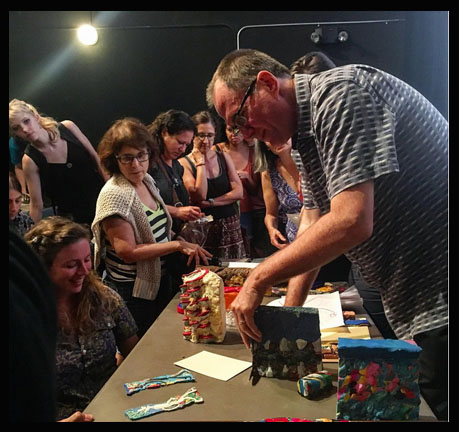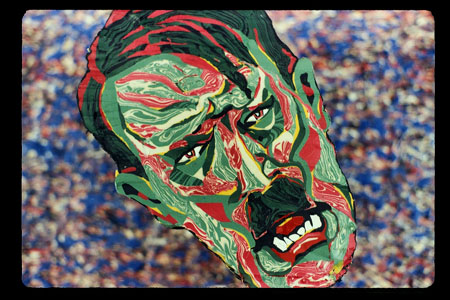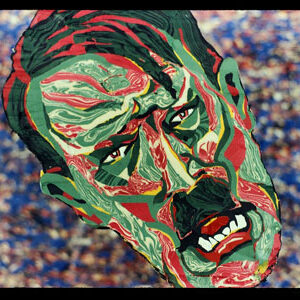“Well, if they don’t want you as an animator, you can always be a camera man.” And with this bit of encouragement, David Daniels started his NY career at the Broadcast Arts animation studio. Daniels had just screened Buzz Box as part of his interview, and it was met with mixed results. Buzz Box (Daniels, CalArts 1985) is inspired by a childhood watching the Vietnam War on TV: by the incongruity of Walter Cronkrite reciting body counts and the capitalistic euphoria of intervening advertisements. On Saturday September 10th, at the Anthology Film Center in New York’s Bowery district, we were treated to a special Show & Tell presentation by David Daniels. There were lots of his old New York animation friends, in a packed house.

David Daniels giving away strata cuts to eager fans; source credit: non films
Buzz Box is an alt reality mash-up of TV culture; a film that Daniels himself viewed as “too fast” when he made it and “too slow” when he sees it now, which is only a testament to the vast cultural differences in editing in a few short decades. The film describes a dystopian network’s weekly programming, hammering in each day of the week with shows like “War Gasm,” illustrated in Crayola-ayahuasca colors. Daniels’ work is frequently described as ‘hallucinatory,’ but I feel like this is misleading, as his particular art-form is grounded in very real process. “Strata Cut“ is the term used for creating a ‘loaf’ of clay, that as it is cut away in slices, is photographed, and reveals the animation. This means that Daniels has to mold objects that extend and morph along the z-axis, factoring in complications of distortion and the angle of the cutting blade. “A pre-programmed piece of motion sculpture,” with shapes that distort over time.
The film Buzz Box is a stream of ‘talking head’ news anchors, military vehicles, television screens, viewers, and more. Not content to be simply visually unique, it is also born for the VHS, and run at 36 fps, because that’s how Daniel cranked it till it seemed ‘correct.’ In 2005 Daniels remixed the film, “adulterating the purity of the original” by adding sound clips of the 2nd President Bush (new-clear/nuclear) to the 1985 original, juxtaposing the original tragedy of President Reagan with the farcical Bush. The soundtrack is a distorted mash of sound bytes and sound effects, TV channel scanning of a by gone era. Daniels screened this new version, which runs at 9 minutes, as opposed the original 15. Strata Cut becomes a metaphor for mass production, as a clay tank appears, and is perpetually sliced away to produce more and more tanks, like Andy Warhol printing many pieces with slight alteration.

Buzz Box, 1985, David Daniels
Strata Cut is a both a 2D and a 3D medium, according to Daniels. There is context to the sides of the block of clay, and potential for clues when you can see shape hints of what is coming up next. David Daniels was instrumental in inventing this medium, but not alone. The Adventures of Prince Achmed (Lotte Reiniger, 1926) had some prototypical strata cut, in the scenes where the evil wizard conjures up a magical beast. Wax was dripped to form creatures, and sliced away into phantasms. Walter Ruttmann also had his version, and Oskar Fischinger. Daniels thinks of strata cut as a form of fireworks, lighting the fuse of an explosion of coherency and in-coherency.
When Daniels was a child, he joined his sisters at play in “Clay-Town.” This cute little neighborhood was quickly gentrified by Daniels into a complex diorama, with individually sculpted minarets and shop-keeper signs. Daniels described a sense of de-ja-vu when he first saw Stanley Kubrick’s 2001: A Space Odyssey (1968) since he shared the same name as Dave. And so we were treated to a cute yet bizzare photo slide-show detailing Daniel’s beginning in clay-mation, winning a film contest with a free trip to NY’s Plaza hotel at 14 years old, and his first tests in strata cut, all ‘narrated’ by the 2001 scene where (spoiler alert) H.A.L. is deactivated.
Daniels would introduce several clips of his work, and take questions in between. The program included
BUZZ BOX (1985/2005, 9.5 min, video) ACID TRIP (2000, 40 sec, video)
PEE WEE’S PLAYHOUSE COLUMBUS (1987, 30 sec, video)
PEE WEE’S PLAYHOUSE 4th of JULY (1987, 20 sec, video)
AMNESTY INTERNATIONAL (1990, 30 sec, video)
https://vimeo.com/23609041
MICHAEL JACKSONS’S ABC (1988, 15 sec, video) – This particular animation was shot in reverse, which proved a challenge for all that shoulder-shimmying. But everything was carefully tick-marked along the z-axis for correct lip-sync and musical hits.
IDIOT BOX (Title Sequence) (1991, 40 sec, video)
PETER GABRIEL’S BIG TIME INTRO (1986, 30 sec, video) – The lake-bed animation was another animation challenge. The drying mud and bubbling cracks were created by a combination of hard clay layered over soft, that dryed and cracked, as bubbles were slowly injected with needles frame by frame and a special wooden rig of pedals built underneath to make the bed pulse to the music.
BIG TIME STRATA CUTS (excerpts) (1986, 30 sec, video) CLEARASIL (1995, 20 sec, video)
MTV ‘PIECE OF CAKE’ (1993, 10 sec, video) NBC LOGO (1993, 10 sec, video)
OH NO NOT THEM (1990, 20 sec, video)
SESAME STREET 1 TO 40 (1990, 90 sec, video) – A monolith. 40 feet of clay, shot in a 20 foot garage, built like a series of train cars, and shot in 4 weeks. A simple premise, just a ragtime band singing, and animation of numbers counting up to 40. This particular video was shot with the clay progressing forward, and utilized a ‘coin-conveyer-belt’ technology built by Rob Lyons (professor University of the Arts), one of Daniels’ co-workers. Unfortunately it was only screened once or twice on Sesame St, as later generations of producers were concerned that some of the rotating numbers would confuse dyslexic children. We saw a side by side comparison with an alternate camera, that provided a side angle view, giving us more of the upcoming ‘context clue shape hints’
JOURNEY THROUGH A MELTING BRAIN / GARY AND MIKE SHOW (~2009) – This clip was also shown at 3x slower speed, to illustrate the use of a rotating strobe light. This light hit only the sides of strata cut clay loaf, adding peripheral elements of life to the whole piece.
“And much, much more!”
Daniels demonstrated his love of the form’s hardiness by picking up a block of strata and dropping it, praising the integrity of the animation, but later bemoaning the clay’s tendency to melt in the heat of the subway, and become brittle over the years. He also gave an extensive lecture on the process of strata cut, in person and via videos of his younger self. Creating colored clay was a time intensive and difficult process, so Daniels settled on a variety of about 20 different standard colors. He was more interested in the Impressionistic color theory, where different colors are placed next to each other to create an impression of color, rather than actually mixing the tones. Daniels’ videos also demonstrated how adjusting the angle that you placed the knife to cut the clay affected the animation, as well as techniques for creating simple textures and rotating objects. In the case of a rotating head, Daniels even builds the ease in ease outs into the animation by adding a tapering element to the top and tail of the whole strata… And while his strata walk cycles are rough, he has streamlined them into molds for faster production.
When we viewed the results of these techniques (and harkening back to Buzz Box) Daniels felt the need to emote. “I’m a little bit angry in some ways, but mostly with the universe.” He lived most of his young animating life sleeping in a van, and working in a small stuffy studio the size of a closet. He didn’t get paid for Freaked movie’s titles but negotiated a film credit. Daniels does not like knives, but art drove him into a type of madness, like physical endurance driven from army boot camp, that caused him to wield the blade. Someone, he doesn’t know who, nicknamed him the “Insanimator” in CalArts. He had to keep the studio very clean for the other anal animation students. He just animated and slept, passionate but delusional.

A slice of Strata signed by Daniels himself!
Daniels admires Banksy because he places his art in unusual places, so context is important. Daniels even has about 15 feet of uncut strata, because he is waiting for a time when ‘technology makes more sense for it to be practical to film.’ This is unfortunate since the strata is about rotating electrons in the atom, and the creation of the universe, and he showed us video of the creation of the strata itself. Thin cords of clay, either nucleus or nebula, are formed and propped up in their unstable infancy by foam blocks as Daniels adds more and more swirling whirlpool elements until it becomes a thick log. A log of unknowable, barely imaginable art, waiting to be birthed into animation.
Today, David Daniels lives in Portland, Oregon, at his company Bent Image Lab. He has transitioned from clay to augmented reality, of all things. Daniels has made experiments in CGI strata cut. Playing with concepts such as a circular blade, strata made of video, strata made of CG models, and negative space (and time!). He showed a 4-minute animation test of a ballerina from video footage and computer models that he felt wasn’t ready, but I think needs to hit the festival circuit. The standard def video of the dancer is presented in a regular strata block, seamlessly animating forward and back as a usual clay strata might, but quickly changes from there. Sometimes the video is a 3d cgi model, sometimes it is just a video. Maybe the block is in a straight line, or maybe it follows the dancer’s movement, or the camera’s, twisting or turning into a whorl, a volumetric sculpture that defies classification. Sometimes the block reverses and we see the dancer only in negative space. Or a slice is cut out and the dancer comes to grips with her own tortured animated existence, squashed and stretched and pushed flat, losing her footing… Only a small test is on Youtube, but I could watch the whole piece over and over again.
Not content with CGI modeling, Daniels is pursuing augmented reality. He says 64k resolution is on the horizon and video will soon match the resolution of the human eye. He wants to make a hallucination in virtual reality. But Daniels is still trying to find the perfect way to express his vision, with ‘on-the-fly AR.’ He has experimented with Pokemon Go! of all things. He believes that the sight of all the young kids in the park playing Pokemon Go! is a cultural phenomenon equivalent to Steve Jobs holding up the first iPhone. Bent Image Labs has made a much more grounded version, in which virtual Charmander can walk down steps of the real life environment (as seen through the iPad’s camera eye) and Mew casts accurate shadows on the ground as it drifts through the air. Daniels wants a ‘z-space version of the Internet,’ where you can express political thought by projecting Godzilla climbing onto the Empire State building or the White House (I will leave the analysis of those difference to future bloggers).
The end result would be to give the audience/viewer control over the blade that cuts the strata. It would be a different world in which the movie screen in no longer the main medium in which we view animation. “When everything is mapped, your life is very invaded already, so that’s a necessary evil of augmented reality.” I could not in good conscious let this statement fly, so I asked Daniels if he had seen The Congress (2013). In this French-Isreali film, Robin Wright (playing herself) sells her image to a movie studio so that a virtual form of herself can keep making movies forever. We skip ahead a decade or so in time in the film to strange world where people snort drugs to live in an animated Toonsville wonderland, where people shop in virtual goods for their avatars, only to be revealed that the poor dumb shuffling cartoon masses live in filth, worshiping their fake Steve Jobs idol, while they are gently maintained by an intellectual elite who quietly read paper books in their blimps. Daniels has (unspecified) problems with the movie, but his son loves it (and his son also works at Bent Image Labs, on the computer animation side). This is quite a jump from clay. Daniels is on a deep technological journey right now, perusing lofty ideas such as social/augmented/media/reality. He might be content to be portrayed as a starving artist, but I have more faith in his eventual financial success.
In the 1980’s, Daniels taught himself to use a motion control camera rig, with simple 2 key commands. Today, he is exploring new opportunities in the latest tech. We can only hope to catch more context clues on the sides of his upcoming strata, trying to imagine the shape of things to come.

